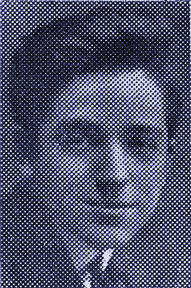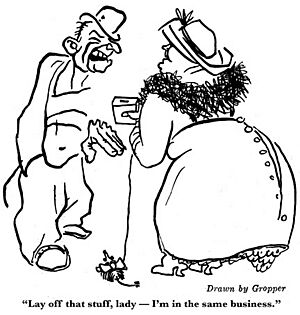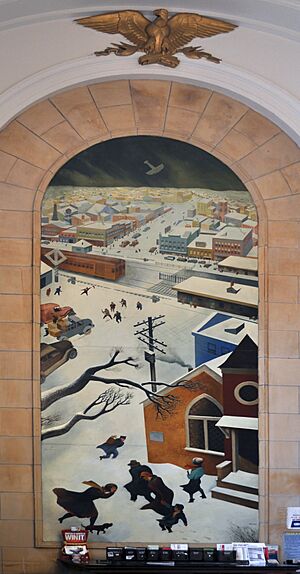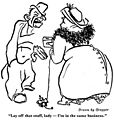William Gropper facts for kids
Quick facts for kids William Gropper |
|
|---|---|

Gropper in 1923
|
|
| Born | William Gropper December 3, 1897 New York City, U.S. |
| Died | January 3, 1977 (aged 79) Manhasset, New York, U.S. |
| Area(s) | Cartoonist, painter, lithographer, and muralist |
|
Notable works
|
political work for left wing publications like The Revolutionary Age, The Liberator, The New Masses, The Worker, Morgen Freiheit |
| Spouse(s) |
Gladys Oaks
(m. 1921)Sophie Frankle
(m. 1924) |
| Signature | |
William Gropper (born December 3, 1897, died January 3, 1977) was an American artist. He was a cartoonist, painter, lithographer, and muralist. Gropper was known for his strong political beliefs. He used his art to share his ideas. He drew for many left wing (or politically progressive) magazines. These included The Revolutionary Age, The Liberator, and The New Masses.
Contents
Gropper's Early Life and Art
William Gropper was born in New York City on December 3, 1897. He was the oldest of six children. His parents, Harry and Jenny Gropper, were Jewish immigrants. They came from Romania and Ukraine. They worked hard in the city's clothing factories. The family lived in poverty on New York's Lower East Side.
Gropper's father was very smart and knew many languages. But he could not find a good job in America. This made William Gropper feel strongly against capitalism. He believed the economic system was unfair.
A Tragic Event
On March 24, 1911, a terrible event happened. Gropper lost his favorite aunt in the Triangle Shirtwaist Factory fire. This fire was caused by locked doors and no fire exits. About 146 workers died. Many burned or jumped to their deaths. This disaster showed the dangers of sweatshops. It deeply affected Gropper.
Discovering Art
Gropper loved art from a young age. When he was six, he drew elaborate stories on sidewalks with chalk. As a child, he helped his mother. He carried bundles of her sewing work to the factories.
At age 13, Gropper began his first art lessons. He studied at the radical Ferrer School. His teachers were famous artists like George Bellows and Robert Henri.
Moving Forward in Art
In 1913, Gropper finished public school. He won an art medal and a scholarship. This allowed him to study at the National Academy of Design. But Gropper was very independent. He did not like to follow strict rules. So, he was expelled from the academy.
He tried to go to high school. But his family needed money. He had to find work to help them. He worked in a clothing store.
In 1915, Gropper showed his art to Frank Alvah Parsons. Parsons was the head of the New York School of Fine and Applied Arts. Parsons was very impressed. He offered Gropper another scholarship. Gropper kept working part-time while he studied art. Over the next two years, he won awards for his work.
In 1917, Gropper got a job at the New York Tribune newspaper. He drew pictures for their Sunday features. This gave him a steady income.
Gropper as a Political Artist
Around this time, Gropper became involved with a group of artists. They worked for a left-wing magazine called The Masses. This magazine was banned in 1917. This happened because it was against war. Gropper then joined other artists. They contributed to The Liberator, which was the next version of The Masses.
Gropper also drew for other radical publications. These included The Revolutionary Age and The Rebel Worker. The Rebel Worker was a magazine for the Industrial Workers of the World. This was a union that believed in workers' rights.
Travel and New Experiences
In 1920, Gropper traveled to Cuba. He worked on a freight boat. He stayed in Cuba for a while. He observed life there and worked on a railroad. He had to return home because his father was very sick.
In 1921, Gropper officially joined The Liberator staff. He worked with editor Max Eastman. The magazine later came under the control of the Communist Party.
In August 1921, Gropper married Gladys Oaks. She also wrote for The Liberator. They wrote a book together called Chinese White. Their marriage was short. In 1924, they separated.
Gropper also drew for mainstream magazines. He made caricatures (funny drawings) of authors for The Bookman. He also drew for The Dial.
In the fall of 1924, Gropper married Sophie Frankle. She was a bacteriologist. They built a stone house in Croton-on-Hudson, New York. They raised their family there. Soon after their marriage, they spent a year in the Soviet Union. Gropper worked for a short time at Pravda, a newspaper of the Communist Party there.
Even though he contributed to many communist publications, Gropper was never officially a member of the Communist Party USA.
In 1927, Gropper visited Soviet Russia again. He went with famous writers Sinclair Lewis and Theodore Dreiser. They celebrated the tenth anniversary of the Russian Revolution.
Fighting Fascism with Art
During the late 1930s, Gropper used his art to fight fascism. Fascism was a political movement that was very controlling and often violent. He wanted to raise awareness and opposition to it in Europe.
In 1937, he received a Guggenheim Fellowship. This is a special award for artists.
Gropper also created murals for public buildings. In 1938, he painted two murals for the Freeport New York Post Office. These murals are called Air Mail and Suburban Post in Winter. They were part of a government program. This program helped artists during the Great Depression. Gropper also worked for the Works Progress Administration (WPA).
In 1953, Gropper was called before the House Un-American Activities Committee. This committee investigated people suspected of being communists. This experience inspired Gropper. He created a series of fifty lithographs called Caprichos.
After World War II, Gropper went to Poland. He attended a peace conference. He then decided to honor the Jewish people killed in the Holocaust. He painted one picture each year about Jewish life.
Later Years and Legacy
In 1974, Gropper became an Associate Academician of the National Academy of Design. This is a respected art organization.
William Gropper died on January 3, 1977. He was 79 years old. He passed away in Manhasset, New York.
Works by William Gropper
- Chinese White: Poems. With Gladys Oaks. New York: Melomine Publications, 1922.
- Di Goldene Medina [The Golden Land]. In Yiddish. New York: Freiheit Publishing Co., 1927.
- Alay Oop. New York: Coward-McCann, 1930.
- Gropper. New York: A.C.A. Gallery Publications, 1938.
- The Little Tailor. New York: Dodd, Mead & Co., 1955.
Images for kids






